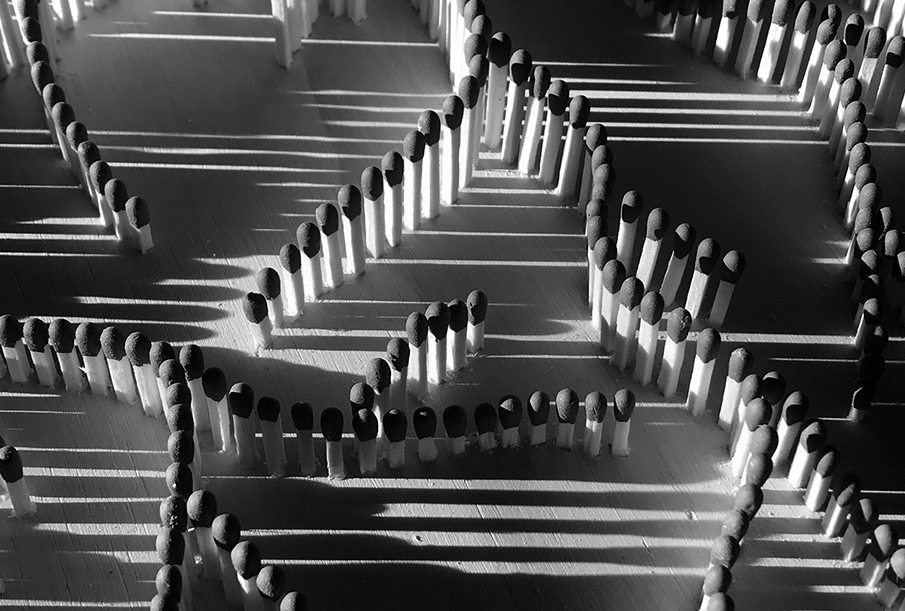ITP Alum Dr. Ernesto Rios has opened up a Solo Exhibition at the UPAEP Museum in Puebla, Mexico.
Interconnections
The creativity of Ernesto Ríos refers to the creation of a discourse derived from the interconnection of shapes and lines on two- and three-dimensional objects that simulate codes, signs and symbols. His work is based on recognizing the creative human capacity for language in order to point out the different elements that are used to construct it.
Approaching to signs, symbols and codes is to inquire into the basic need of man to relate to others. Language proliferates organically by the human desire to understand, communicate and create. The starting point of language is repetition, understanding and multiplication of the coded symbols that becomes collective, accompanied and shared by intrinsic agreements. Just as language begins with repetition in art it is the same, repetition makes the difference. It’s the birth and the growth of all languages. Ernesto Ríos has interwoven his work in two solo exhibitions (Code_of_the_forest and Constellations) both together show the growth of the integration of sets, until a unified constellation is created.
Just as Ríos seeks to interweave visual and rational elements through a series of pieces, he also searches to produce multiples exhibitions by integrating them all. He explores the birth of a constellation through connection points in order to encourage communication schemes.
The idea of a constellation integrated by pieces and sets is inspired by the concept of interconnections, as it is the structure of DNA. An organic set of art pieces. In other case, Ríos creates architectural shapes with helicoidal structures simulating movement. From the gridded labyrinths it transits to the asymmetric and curved ones, thus originates structures that by their morphology become symbols.
Ríos work awakens visual and rational perception, from the spectator experience in front of an object to the stimulation that fire in slow motion provokes in a swing of time and movement. There is an interaction of elements that wobbles impressions suggesting a symbolic sketch willing to have meaning.
What Ríos presents in this exhibition at the Museum UPAEP in Puebla Mexico, differs from the previous ones. He changes the forms, the use of some materials or the creation of objects that he strips of his primary function to turn them into something else, while retaining the aim of producing a language inhabited by codes. It is about a creative process that overflows the work itself. His work becomes an initiative that advocates the foundations of language, through the multiplicity of connections that emerge from the human aptitude to create.
Natalie Gama Pourdanay
March 2018
Ernesto Ríos (Mexico City, 1975) is a multi-disciplinary visual artist who works with a diverse palette of tools: drawing, painting, video, photography, animation, virtual reality, performance, interactive art and net-art. He was born in Mexico where he studied Photography, Hispanic Literature and Linguistics, History of Art and Fine Arts. Ernesto also holds a Masters Degree from Tisch School of the Arts (Interactive Telecommunications Program) at New York University and a PhD of Philosophy at RMIT University. He has had 23 solo exhibitions and 65 group exhibitions in major cities such as London, Paris, Tokyo, New York, Valencia, São Paulo, Melbourne and Mexico City.
Natalie Gama Pourdanay (Mexico City, 1986). She has a degree in Humanities, with a specialty in Philosophy, from the University of the Americas, Puebla and a Master in Modern and Contemporary Art at Casa Lamm in Mexico City graduated with honors. For more than four years, she was the deputy director of the Museum of the Ministry of Foreign Affairs, where she managed more than seventy collective and individual exhibitions of contemporary art and documentary photography; In addition to his main duties, he was in charge of the museography and curatorship of many of them. Currently, he is part of the Art Advisory Committee of the Direction of Visual and Performing Arts of the Mexican Metropolitan University.
